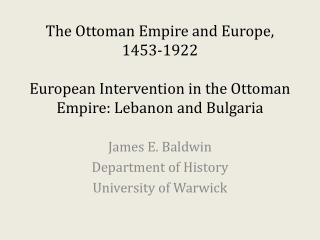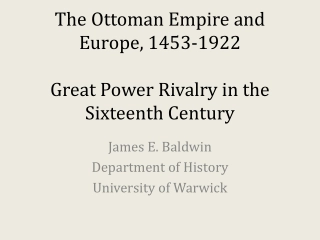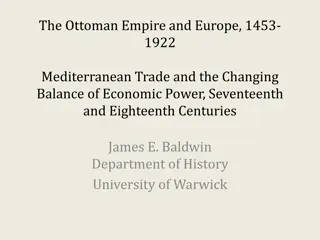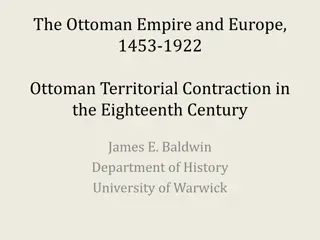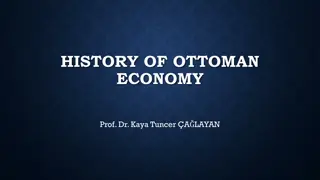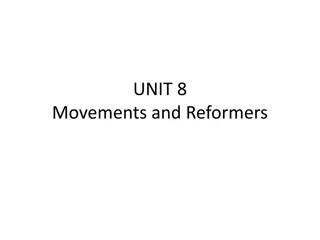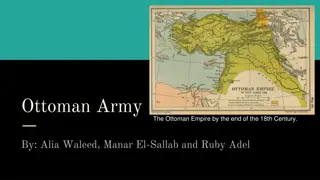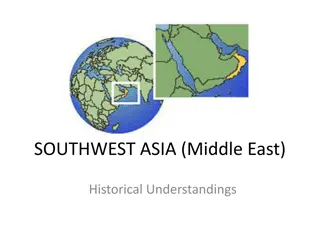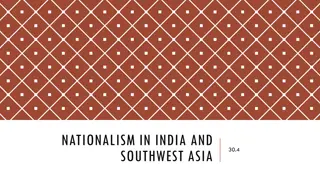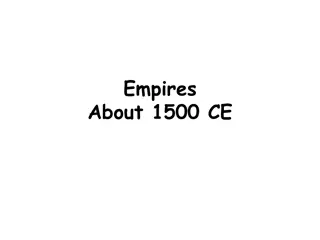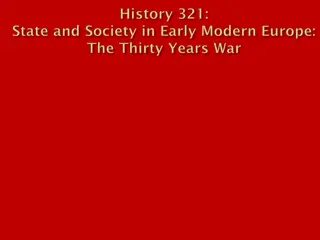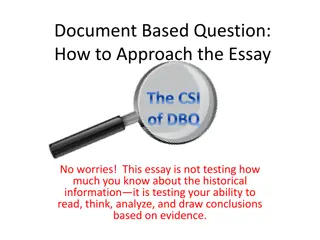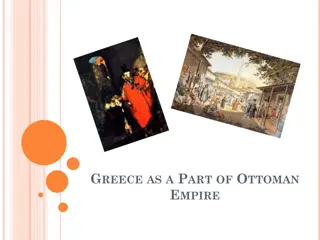European Humanitarian Intervention in the Ottoman Empire
Explore European powers' moral duty to intervene in Ottoman affairs during the 19th century, motivated by humanitarian and imperial interests. Discover the impact of the Concert of Europe and legal theories on humanitarian intervention.
3 views • 22 slides
The Ottoman Empire and Europe, 1453-1922
The interaction between the Ottoman Empire and European powers, including the Habsburgs, Safavids, Mamluks, and Russia, shaped the geopolitical landscape of the 16th century. This period saw Ottoman expansion, clashes between different empires, and complex motivations behind territorial conquests, i
0 views • 16 slides
Reform Efforts in the Ottoman Empire: 18th and 19th Century Transformations
The Ottoman Empire underwent a series of reforms from the late 18th to the 19th century, aiming to centralize power, boost revenues, strengthen the military, educate bureaucrats, refine legal systems, and improve healthcare. Factors driving these reforms included military weaknesses, separatist nati
0 views • 19 slides
Ottoman-European Economic Relations and Mercantilism in the 16th Century
The Ottoman Empire and Europe traded various goods in the 16th century, with a negative trade balance favoring the Ottomans. Institutional innovations like the Joint-Stock Company and the Levant Company emerged to facilitate trade and secure better terms. Mercantilist policies were implemented to re
2 views • 15 slides
Coffee and Orientalism: Exploring the Relationship in the 1700s
Delve into the intriguing history of coffee and its role in shaping the relationship between Europe and the Ottoman Empire around 1700. Learn about the perceived virtues of coffee, the various types in circulation, and the significance of these differences. Images and quotations offer a vivid insigh
1 views • 7 slides
Ottoman Empire Territorial Contraction in the 18th Century
Ottoman Empire faced agricultural and fiscal crises in the 17th century, leading to internal rebellions. However, by the mid-17th century, the empire had recovered and experienced further expansion, albeit at a slower rate compared to the previous century. In the 18th century, the Ottomans suffered
2 views • 12 slides
Understanding Libyan Civil Law: Sources and Application
Civil law in Libya draws influences from Ottoman, French, Italian, and Egyptian sources, with a move towards a legal system based on Sharia. This article discusses the priority of using Libyan Civil Law sources and emphasizes the importance of laws that cater to the wellbeing of its citizens. The so
1 views • 7 slides
Overview of the Ottoman Empire's Economy and Social Structure
The history of the Ottoman Empire's economy and social structure encompasses its Turkish and Islamic influences, as well as its geographical diversity across regions like Asiatic, East European, and African territories. The empire's centuries-long existence from 1300 to 1918 saw distinct periods of
3 views • 105 slides
Khilafat Movement in India: A Historical Perspective
The Khilafat Movement was a significant event in Indian political history, triggered by the British not fulfilling promises made to protect Turkey during World War I. The movement aimed to safeguard Turkey's holy places, restore its territories, and revive the Ottoman Empire. Despite efforts, includ
0 views • 30 slides
Government Responses to Economic Change in Qing China and Ottoman Empire
Explore the similarities in government responses to economic change in Qing China and the Ottoman Empire during the late 19th and early 20th centuries. Discover how both empires sought to uphold traditional values amidst global modernization trends, shaping their strategies for economic stability an
0 views • 14 slides
Rise and Fall of the Ottoman Empire's Military Power in the 18th Century
The Ottoman Empire's military success in the 18th century was attributed to their expertise in using gunpowder, loyal soldiers, strong organization, multilingual education, and strategic planning. However, the empire faced decline due to dated cultural practices and increasing European power, leadin
1 views • 17 slides
Melancholy: The Soul of Istanbul - Chapter 1.5 Theme and Excerpts
Explore the deeply rooted melancholy intertwined with the history and identity of Istanbul. The excerpts delve into the city's transformation post the Ottoman Empire, personal reflections on fate, and the impact of westernization. Discover how Istanbul's melancholic aura shapes the narrator's perspe
0 views • 12 slides
European Imperialism in the Middle East: A Historical Overview
Empire of the Turks and the 18th-century Ottoman Empire played significant roles in the power dynamics of the region, with conflicts over control of the Black Sea and territories. Napoleon's expedition into Egypt further intensified European interest in the Middle East, impacting trade routes and re
0 views • 41 slides
Historical Background of the Middle East's Regional Conflicts and the Establishment of Israel
European partitioning after the Ottoman Empire's breakup led to regional conflict in the Middle East. The establishment of the modern State of Israel in 1948 was influenced by Jewish religious ties to the land, the Holocaust, anti-Semitism, and Zionism in Europe. This historical context also sheds l
0 views • 12 slides
Nationalism in India and Southwest Asia: A Historical Overview
The aftermath of World War I led to a surge in nationalism in India and certain Southwest Asian countries, as empires like the Ottoman Empire and the British Empire showed signs of weakening. Indian nationalism grew due to factors such as promises of reform by the British, religious divisions, and e
0 views • 15 slides
The Empires and Explorations of 1500 CE
Explore the empires and events of 1500 CE, from the Ottoman Empire to the Mughal Empire, and the reasons behind European exploration. Immerse yourself in the history of trade, culture, and conquests that shaped this era.
0 views • 26 slides
The Thirty Years War: Bohemian Revolt and European Conflict
The Thirty Years War began as a clash over political and religious issues with the Bohemian Revolt in 1618. Despite initial intentions for limited involvement, major powers were drawn into a prolonged conflict lasting three decades. The war involved various factions, including Protestant assemblies,
0 views • 20 slides
Unveiling the Strengths and Weaknesses of Muslim Empires
Explore the rise and fall of the Ottoman, Safavid, and Mughal empires through a document-based question (DBQ) essay. Understand the factors attributing to their success and decline, analyze historical backgrounds, and discuss potential empire-building strategies. Dive into the investigation with cri
0 views • 10 slides
The Impact of World War I and Its Aftermath
Explore the significant events post-World War I, including the fall of the Ottoman Empire, creation of new treaties, and the Sykes-Picot Agreement. Delve into learning objectives related to analyzing the world changes, the Armenian Genocide, and connections to ISIS. Reflect on the importance of Pale
0 views • 36 slides
Ottoman Occupation of Greece and Its Impact on the Greek Population
The Ottoman occupation of Greece brought about significant challenges for the enslaved Greek population, including heavy taxes, mass kidnappings of children, danger of violent Islamization, and the closure of Greek schools. Despite these difficulties, enforcement factors such as traditions, developm
0 views • 10 slides
